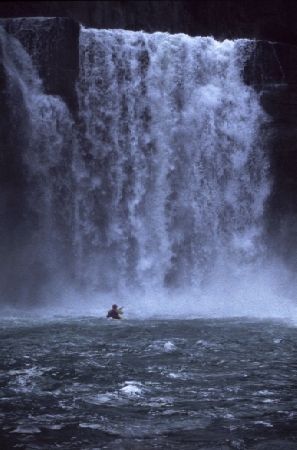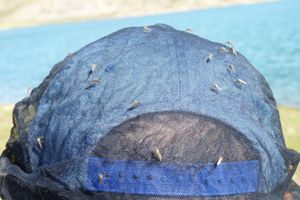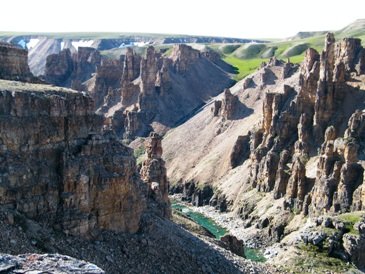
Safety and guidelines
Tuktut Nogait National Park
Your Partner: Parks Canada

Parks Canada is responsible for providing a public safety program that deals with the specific incidents and issues encountered within each heritage area. Although there is national coordination of the public safety program, levels of service and methods of dealing with incidents vary from one heritage area to the next.
As your partner in safety, Parks Canada wants to help you enjoy your trip and stay safe. To help ensure the safety of our visitors, Parks Canada engages in visitor risk management and public safety planning, builds and maintains facilities (such as trails, hazard signs and overpasses to prevent wildlife from crossing in front of traffic), and works with other government departments and non-governmental agencies to provide trip planning and safety information, as well as search and rescue services.
Your Responsibility as a Visitor
Parks Canada also recognizes that park visitors have a certain responsibility for their own safety, and that risk management must become an integral part of their experience. While some visitors recognize the risks involved in outdoor recreation, and are prepared for their adventures, many others don't know what they're getting into. That means they're unable to choose effectively between taking a smart risk and a foolhardy one. The rising popularity of adventure travel and outdoor pursuits makes it particularly important to ensure that visitors take responsibility for their own safety. Parks Canada asks that you share the responsibility for your visit to protected heritage areas to help ensure a safe, enjoyable and memorable visit.
Tuktut Nogait Park is a wilderness area

© Parks Canada / G.Wall
Representing the Tundra Hills Natural Region of Canada, Tuktut Nogait is one of the most isolated national parks in North America. The closest community is the arctic hamlet of Paulatuk, 40 km by air to the west of the park. Weather can be extreme here and there are no visitor facilities in the park. Parks Canada does not have search and rescue staff based at Tuktut Nogait, search and rescue staff are shared between Western Arctic national parks. Search and rescue operations may be delayed by poor weather, geography, aircraft availability and more.
The only first aid available to your party may be the expertise of your party. Visitors should be physically fit and experienced wilderness travelers. They should have advanced wilderness first aid skills and be ready and equipped to handle any medical or weather related emergency.
Having a safe and enjoyable trip in Tuktut Nogait requires careful planning and preparation.
- assess conditions and only cross if judged safe to do so
- seek shallow crossings with the least current possible
- cross early in the day when water levels are at their lowest;
- wear boots or sandals to prevent cuts from sharp stones and to give you better footing;
- do not use hip waders, as they may fill with surging water during crossing attempts;
- undo the waist belt and chest strap of your backpack;
- use a walking stick, positioned upstream to provide more support;
- move across the stream in a diagonal fashion, facing upstream and yielding to the current;
Weather
The weather in Tuktut Nogait can be extremely hostile. Long spells of rain, ice-cold winds snowstorms and frost are not uncommon, even in mid-summer. Sudden and heavy fog can appear at any time during the summer and early fall. Attempting to travel on such days can be hazardous. There is little natural protection in the open tundra terrain. Park visitors must bring sturdy equipment, sufficient warm clothing and rain gear, as well as plenty of fuel for their portable stoves.
Hypothermia
Hypothermia is the cooling of the core body temperature to below 35°C; if not stopped, symptoms can progress from slurred speech and lack of co-ordination, to uncontrolled shivering, to loss of consciousness and finally to heart failure. To avoid hypothermia: eat high energy foods, avoid travelling in extreme weather, dress warmly and immediately change out of damp or wet clothing.
Water Quality
Unfortunately, cases of Giardiasis (beaver fever) have been reported in Tuktut Nogait. Giardiasis is caused by a protozoan parasite that is found in many wilderness areas of Canada. Giardiasis can result in mild to severe symptoms of abdominal pain, cramping, nausea and exhaustion. Dehydration can be a significant risk. Treat your water by filtering (<0.5 microns), boiling or chemical treatment (iodine treatment has been found to be more effective than chlorine for Giardia).
Rabies
Rabies is a serious disease that affects the nervous system and brain. People can acquire rabies from animals that are infected with the virus. Usually, it is spread when a rabid animal bites another animal or person. In Tuktut Nogait, animals such as foxes, wolves, bears and caribou may be carriers of the virus.
Be suspicious of any friendly, tame or unusually bold animals. Keep a safe distance from all wildlife and remember that it is illegal under the Canada National Parks Act to touch, feed, approach, or entice wildlife.
Biting Insects
Biting insects, such as mosquitoes and black flies, can be very bothersome on warm, calm days. However, the usual cool temperatures and frequent winds generally keep them at bay. Consider bringing a small supply of insect repellent, a bug jacket and a bug hat.

Bears
Tuktut Nogait is home to barren-ground grizzly bears (Ursus arctos). They are found throughout the park and are especially abundant in the more vegetated areas. Before your trip, we recommend that you become familiar with the brochure, You are in Black Bear and Grizzly Bear Country, available from the Parks Canada Office in Inuvik. Another excellent resource is the video, Staying Safe in Bear Country, available for viewing at either Parks Canada Office.
Always practice proper camping, food preparation, and food storage procedures. Travel in groups, stay alert and watch for fresh signs of bear activity. When hiking, advertise your presence by calling out, singing or talking loudly, especially near streams and in the dense shrub vegetation along valley bottoms. If you encounter large dead animals leave the area immediately.
Polar bear distribution is closely related to the distribution of multi-year pack ice. Most polar bears remain on the drifting pack ice throughout the summer and should not pose a problem to park visitors. They may, however, be encountered along the coast during periods when the permanent ice pack is blown south towards the mainland.
Learn how to deal with bear encounters and find out recommended types of bear deterrents from Parks Canada staff in Inuvik. Firearms are not permitted within Tuktut Nogait.
The Tuktut Nogait Agreement recognizes the inherent value of healthy bear populations in the park and the economic value of bear hunts to the residents of Paulatuk.
Muskoxen
Muskoxen, although not numerous, are found throughout the park. While muskoxen may appear quite docile, they can be extremely dangerous and should not be approached. This is especially true of rutting bulls. Muskoxen will charge; always keep a safe distance.
River Crossings
Small creek crossings are a common part of any hiking trip in the park. The crossing of bigger waterways such as the Hornaday and Brock rivers can be extremely dangerous, especially following extensive periods of rain and during the spring melt. Crossings on these rivers should only be attempted during periods of low water and by individuals competent in swift water crossings in a backcountry environment.
When crossing creeks and rivers:
Waterfalls
Numerous beautiful waterfalls are found along the waterways of the park. A great number of these waterfalls are located in steep canyon sections where the surrounding terrain is often rocky, muddy, slippery and very unstable.
There are no guardrails or other protective devices in the park. Please take extreme caution when exploring around waterfalls or when taking photographs. An unfortunate step could have grave consequences.
Flash Floods
Permafrost and thin vegetation cover in the vicinity of the park’s many canyons contribute to rapid run-off during heavy rain showers. The subsequent heavy influx of water into the many small, narrow box canyons can quickly lead to flash flooding.
Please avoid entering canyons during long spells of rain or during hot spring days when meltwater comes from snow lingering in many of the side valleys.
Unconsolidated Slopes
Many of the steep slopes found near canyons, along river banks and in other areas of the park are comprised of unconsolidated material. Stone, sand and mud slides present a hazard in these areas. Do not attempt to enter, climb or traverse steep slopes during rainy periods and avoid them when choosing your campsite.

© Parks Canada / Shane Goeson
Undercut Banks and Overhanging Canyons
Many of the natural hiking routes in the park follow riverbanks for short periods. These sections are often below undercut banks and overhanging rock cliffs with the potential for injury from falling rocks or other debris. Do not seek refuge under overhangs during bad weather and, if an alternate route is available, avoid overhangs altogether.
Route Finding and Orientation
Most of the park’s hiking routes follow unmistakable natural landmarks such as rivers, canyons and eskers. These landmarks are easily identified in the field and are indicated on topographical maps. Navigation and route finding along these features is generally easy.
Less experienced visitors should not attempt to cross the vast, flat tundra terrain away from the recommended hiking routes. Orientation in these expansive and featureless areas is very difficult. Compasses are unreliable in certain areas of the park. We recommend you carry a good quality Global Positioning System (GPS).
- Date modified :